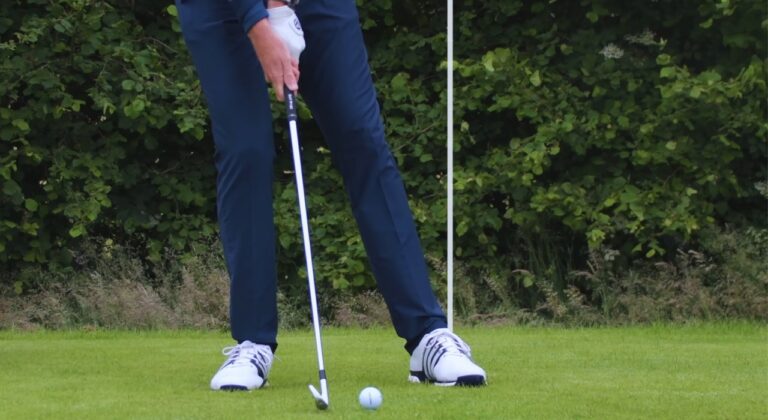Ever stood on the green, heart racing, as you took that crucial putt? I’ve been there. Over the years, I’ve realized that while driving might get all the glory, it’s those subtle moments with the putter that truly define a golfer’s skill.
It’s an art, a science, and sometimes, a bit of luck. But, with the right techniques and a dash of persistence, anyone can elevate their putting game. In my journey, I’ve discovered efficient ways that have transformed my performance on the greens.
And guess what? I’m sharing all those secrets with you.
1. Find High-Quality Equipment
The tools you use can significantly influence your success rate. It’s not just about the brand, but finding the right fit for your unique style. The market offers a plethora of designs, from blades to mallets. It’s essential to find one that feels like an extension of your arm, ensuring comfort and confidence with every stroke.
The connection between your hands and your tool is crucial. Some players lean towards a thicker grip to reduce wrist action, while others prefer something slimmer. It’s all about finding that perfect balance that offers control and comfort.

2. Master the Fundamentals
Before diving into advanced techniques, it’s essential to have a solid foundation. Understanding the basics can lead to consistent and reliable performance on the greens.
- Stance and Posture: A proper stance provides the base for a successful putt. Your feet should be shoulder-width apart, with the ball positioned slightly ahead of the center. This position offers a clear view of the line and allows for a smooth, controlled stroke.
- The Art of the Stroke: Consistency is key. The shoulders should drive the movement, ensuring a smooth and straight trajectory. It’s all about feeling the rhythm and maintaining it, regardless of the putt’s length.
Learn the Secrets of the Greens
The surface plays a pivotal role in the ball’s movement. Accurately reading the green can be the difference between success and a missed opportunity.
- The Surface: Different types can influence the roll. For instance, Bermuda can be grainy, affecting speed and direction. Before making your move, assess the type and any nuances it might present.
- Evaluating Slope and Contour: They aren’t always flat. They have their unique personalities with slopes, undulations, and contours. Recognizing these can change the ball’s path, ensuring you’re always one step ahead.
4. Embracing Pressure Situations

Every player, whether amateur or professional, will face moments where the pressure is palpable. How you handle these situations can set you apart. One way to get comfortable with high-stakes moments is to simulate them during practice.
Set up challenging scenarios for yourself, imagining that each putt is for a tournament win or to beat your personal best. Over time, this mental conditioning can help you stay calm and focused during actual pressure-filled situations. It’s not just about physical practice; the mental aspect is equally crucial.
Incorporate mindfulness exercises and deep breathing techniques into your routine. These can help center your thoughts, reduce anxiety, and improve focus when it matters most.
5 The Importance of Feedback
Feedback, both from yourself and external sources, can be instrumental in identifying areas for improvement.
- Self-Assessment: After each session, take a moment to reflect on your performance. What went well? Where did you struggle? Keeping a journal can help track your progress and highlight patterns over time.
- External Insights: Sometimes, an external perspective can offer invaluable insights. Consider recording your sessions or seeking feedback from a coach or trusted playing partner. They might notice subtle nuances in your technique that you might have missed.
6. Diversify Your Practice Locations
Variety is the spice of life, and this holds true for putting practice as well. Each green has its unique characteristics. By practicing on a variety of surfaces and locations, you expose yourself to different challenges, helping you become a more adaptable and versatile player.
Common Green Types and Their Characteristics:
| Green Type | Speed | Common Challenges |
|---|---|---|
| Bermuda | Fast | Grainy, can affect ball direction |
| Bentgrass | Medium to Fast | Smooth, requires precise speed control |
| Poa Annua | Medium | Prone to bumps, demands accurate reads |
7. Incorporating Technology
In today’s digital age, technology offers tools and resources that can provide a competitive edge in refining your skills on the greens.
- Digital Analysis Tools: There are several apps and software available that can analyze your stroke in real-time. By using slow-motion video and tracking metrics, these tools can provide insights into the minutiae of your technique, highlighting areas for improvement.
- Simulators and Virtual Reality: Golf simulators and VR platforms can replicate real-world putting scenarios. These technologies allow you to practice in various environments and conditions, from the comfort of your home or a dedicated facility.

8. The Role of Fitness and Flexibility
While often overlooked, physical fitness plays a pivotal role in ensuring consistency and reducing the risk of injuries. A strong core provides stability, ensuring a smooth and controlled stroke. Incorporate exercises like planks, Russian twists, and leg raises into your fitness routine to strengthen this area.
Flexibility in the shoulders, wrists, and hips can improve the range of motion and fluidity of your stroke. Regular stretching and perhaps even incorporating practices like yoga can be beneficial.
9. Setting Goals and Tracking Progress
Having clear objectives and monitoring your progress towards them can be a source of motivation and direction. While it’s essential to have long-term aspirations, setting achievable short-term goals can provide immediate motivation and a sense of accomplishment.
For instance, reducing three-putts in a round or consistently making putts from a specific distance can be initial targets. Documenting your practice sessions, noting down achievements, challenges, and areas of improvement can offer a clear picture of your journey.
Over time, this journal can serve as a testament to your growth and dedication.
FAQs
Why is putting so important in golf?
Putting is crucial because it often determines the final score for a hole. A good drive or approach shot can be negated by poor putting. Mastering the art of putting can save several strokes in a round.
What are some common mistakes golfers make when putting?
Common mistakes include not aligning properly, gripping too tightly, not practicing varied putt lengths, and neglecting the mental aspect of the game.
How can technology help in improving my putting skills?
Modern technology offers digital analysis tools, simulators, and VR platforms that can provide real-time feedback, simulate various scenarios, and allow for focused practice, helping refine your putting skills.
How do I know if I’m using the right putter for my style?
It’s about comfort and results. If you feel confident with the putter and see consistent results, it’s likely a good fit. However, experimenting with different types can provide clarity.
Do I need a coach to become a better putter?
While a coach can provide expert guidance and feedback, self-assessment and dedicated practice are also effective. However, occasional sessions with a coach can accelerate improvement.
Closing Thoughts
As I wrap up my insights on elevating one’s putting game, I can’t help but reflect on the countless hours spent practicing, the highs of sinking that impossible putt, and yes, the occasional frustrations too. But here’s the thing: every moment spent on the green has been a lesson.
These nine methods have been my trusty companions, guiding me through challenges and helping me celebrate victories. And while the journey to mastering the art of putting is ongoing, I genuinely believe that with dedication, the right approach, and maybe a hint of patience, anyone can transform their game.
So, here’s to fewer putts, more birdies, and the joy of watching that ball roll seamlessly into the hole.















